History
There is little information about the palace, which was built at the end of the 16th centuryprobably by the architect Gaspare Corte on the commission of Giorgio Centurione, [1] later Doge of the Republic of Genoa in 1621–1622. Giorgio Centurione's daughter, Virginia (1587—1651), later married to Gaspare Grimaldi Bracelli, founder of the order of the Sisters of Our Lady of Refuge in Monte Calvario, was sanctified by Pope John Paul II in 2003. Known as Saint Virginia Centurione Bracelli, she started out in the building in Via Lomellini as a caregiver for poor girls, which was later continued in the convent of Monte Calvario, while the congregation of nuns she founded under the protection of Emanuele Brignole, founder of the Grande Albergo dei Poveri, took the name «brignoline». [2]
The Doria family acquired it in the 18th century. Partially reconstructed in the 19th century (atrium and stairwell), it is currently joined to two other buildings behind it by a bridge over the closed vico del Leone and overlooking vico dell’Oro. [3]

The Palazzo Brignole Sale or Palazzo Rosso is a house museum located in Via Garibaldi, in the historical center of Genoa, in Northwestern Italy. The palace is part of the UNESCO World Heritage Site Genoa: Le Strade Nuove and the system of the Palazzi dei Rolli. The rich art collection inside, along with the galleries of Palazzo Bianco and Palazzo Doria Tursi, is part of the Musei di Strada Nuova and consists of the works of artists of the caliber of Antoon van Dyck, Guido Reni, Paolo Veronese, Guercino, Gregorio De Ferrari, Albrecht Dürer, Bernardo Strozzi and Mattia Preti.

Genoa: Le Strade Nuove and the system of the Palazzi dei Rolli is a UNESCO World Heritage Site which includes a number of streets and palaces in the center of Genoa, in Northwestern Italy.

The Palazzo Angelo Giovanni Spinola is a palace located in Via Garibaldi, in the historical center of Genoa, in Northwestern Italy. It was one of the 163 Palazzi dei Rolli of Genoa, the selected private residences where the notable guests of the Republic of Genoa were hosted during State visits. On 13 luglio del 2006 it was included in the list of 42 palaces which now form the UNESCO World Heritage Site Genoa: Le Strade Nuove and the system of the Palazzi dei Rolli. Now owned by a bank, it is possible to visit the areas open to the public.

The Palazzo Doria or Palazzo Andrea e Gio. Batta Spinola is a palace located in Via Garibaldi, in the historical center of Genoa, in Northwestern Italy. It was one of the 163 Palazzi dei Rolli of Genoa, the selected private residences where the notable guests of the Republic of Genoa were hosted during State visits. On 13 luglio del 2006 it was included in the list of 42 palaces which now form the UNESCO World Heritage Site Genoa: Le Strade Nuove and the system of the Palazzi dei Rolli.
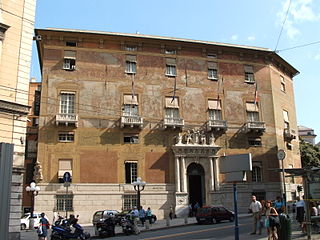
The Palazzo Doria-Spinola or Palazzo Antonio Doria is a palace located in largo Eros Lanfranco in the historical center of Genoa, Northwestern Italy. The palace was one of the 163 Palazzi dei Rolli of Genoa, one of those selected private residences where notable guests of the Republic of Genoa were hosted during State visits. On 13 luglio del 2006 it was added to the list of 42 palaces which now form the UNESCO World Heritage Site Genoa: Le Strade Nuove and the system of the Palazzi dei Rolli. The palace now hosts the Prefecture of Genoa and the seat of the Province of Genoa. It is possible to visit the areas of the building which are open to the public.
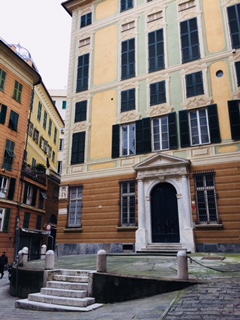
The Palazzo Clemente della Rovere is a palace located in Piazza Rovere in the historical center of Genoa, Northwestern Italy. The palace was one of the 163 Palazzi dei Rolli of Genoa, the selected private residences where the notable guests of the Republic of Genoa were hosted during State visits. On 13 luglio 2006 it was added to the list of 42 palaces which now form the UNESCO World Heritage Site Genoa: Le Strade Nuove and the system of the Palazzi dei Rolli. The palace hosts today the General Consulate of Iceland.

Via Cairoli is a street in the historical centre of Genoa, in North-western Italy, named after the 10th Prime Minister of Italy Benedetto Cairoli (1825-1889). Built in the 18th century as “Strada Nuovissima”, it is one of the Strade Nuove inscribed in July 2006 in the list of UNESCO World Heritage Site Genoa: the Strade Nuove and the system of the Palazzi dei Rolli.

Palazzo Durazzo-Pallavicini or Palazzo di Gio Agostino Balbi is a building on Via Balbi in the historic city centre of Genoa. On 13 July 2006 it became one of 42 palazzi included in the new Palazzi dei Rolli World Heritage Site.
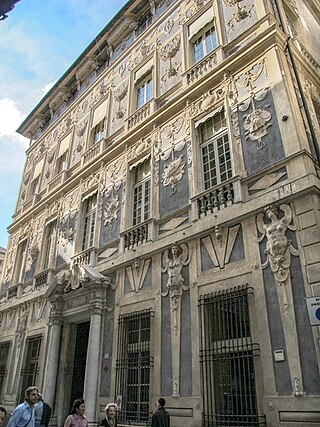
The palazzo Podestà or Nicolosio Lomellino is a building located in via Garibaldi (Genoa) at number 7 in the historical centre of Genoa, included on 13 July 2006 in the list of the 42 palaces inscribed in the Rolli di Genova that became World Heritage by UNESCO on that date.

The palazzo Paolo Battista e Niccolò Interiano or palazzo Interiano Pallavicino is a building located in Piazza delle Fontane Marose at number 2 in Genoa, included on 13 July 2006 in the list of the 42 palaces inscribed in the Rolli di Genova that have become World Heritage by UNESCO.
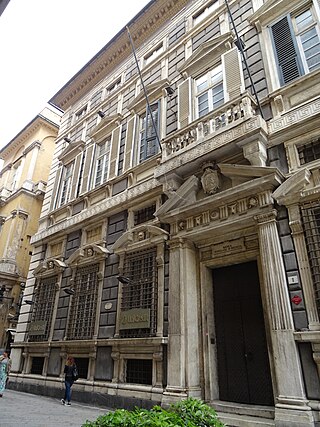
The palazzo Pallavicini-Cambiaso or palazzo Agostino Pallavicini is a building located in via Garibaldi at number 1 in the historical centre of Genoa, included on 13 July 2006 in the list of the 42 palaces inscribed in the Rolli di Genova that became World Heritage by UNESCO on that date.

The palazzo Baldassarre Lomellini also known as palazzo di Cristoforo Spinola or palazzo Campanella is a building located in via Garibaldi at number 12 in the historical centre of Genoa, included on 13 July 2006 in the list of the 42 palaces inscribed in the Rolli di Genova that became World Heritage by UNESCO on that date.
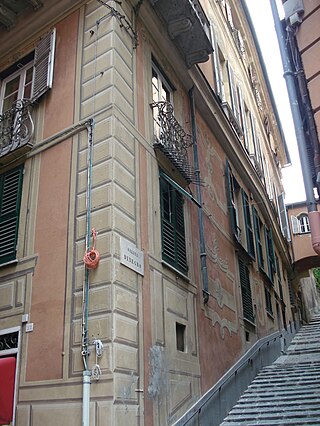
The palazzo Giorgio Spinola is a building located in Salita Santa Caterina|salita di Santa Caterina at no. 4 in Genoa, included on 13 July 2006 in the list of the 42 palaces inscribed in the Rolli di Genova that became World Heritage by UNESCO on that date.
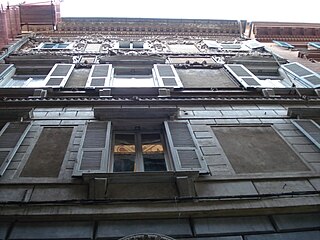
The Palazzo Tommaso Spinola, also known as Palazzo Tomaso Spinola di Luccoli or Palazzo Spinola Pessagno, is a building located in salita di Santa Caterina at number 3 in Genoa, included on 13 July 2006 in the list of the 42 palaces inscribed in the Rolli di Genova that became World Heritage by UNESCO on that date.

The Palazzo Lomellini-Doria Lamb', also called Palazzo Stefano Lomellini, is a building located in Via Cairoli (Genoa) at number 18 in the historical centre of Genoa, included on 13 July 2006 in the list of the 42 palaces inscribed in the Rolli di Genova, which on that date became World Heritage by UNESCO.

The Palazzo Cosma Centurione is a building located in the historical centre of Genoa, in Via Lomellini at no. 8, included on 13 July 2006 in the list of the 42 palaces inscribed in the Rolli di Genova that became World Heritage by UNESCO on that date. Also known as the Palazzo Durazzo Pallavicini or Palazzo di Gerolamo III Pallavicino, from the name of its successive owners, due to its architecture and the frescoes preserved inside, it is an outstanding example of Genoese Baroque.
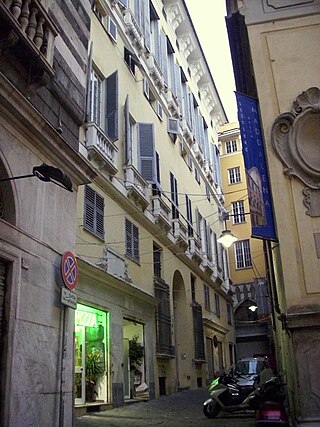
The palazzo Gio Battista Grimaldi is a building located in vico San Luca at no. 4 in the historical centre of Genoa, included on 13 July 2006 in the list of the 42 palaces inscribed in the Rolli di Genova that became World Heritage by UNESCO on that date.

The Palazzo Gio Battista Grimaldi is a building located in Piazza San Luca at number 2 in the historical centre of Genoa, included on 13 July 2006 in the list of the 42 palaces inscribed in the Rolli di Genova that became World Heritage by UNESCO on that date. The Church of San Luca (Genoa) is located in the same square.

The Palazzo Giacomo Lomellini, also known as the Palazzo Patrone, is a building located in Largo Zecca at number 2 in Genoa, included on 13 July 2006 in the list of the 42 palaces inscribed in the Rolli di Genova that became World Heritage by UNESCO on that date.

Giovanni Ponzello was an Italian mannerist architect active in the Republic of Genoa, where he supervised the construction of several distinguished palaces and churches during the Renaissance period.






















